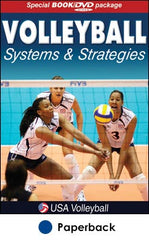Volleyball defensive system drills help improve performance
This is an excerpt from Volleyball Systems & Strategies by USA Volleyball.
Front Row vs. Front Row
(With Back-Row Setter)
Category: Use with chapters 6, 7, 8, 9, 11, 12, and 13.
Objective: To give middle blockers experience in reading where the set will go (to one of three front-row hitters) so a two-player block can be formed.
Players Required: 11-12
Procedure: The tosser on team B tosses to the digger on team A. Team A digs, sets (to any one of the three front-row positions), and hits, while team B blockers defend the attack. Once the ball is terminated, the tosser from the other side tosses to a digger, and the drill repeats. Play a rally score game to 15 points.
Variations: Instruct the setter to set balls that require the middle blocker to travel the greatest distance; this also gives the setter some eye training. This drill can also be played to fewer than 15 points, but start the score so the game will finish on the normal end point (for example, start at 15-15 and play first team to reach 25).
Common Errors and Corrections: Because the middle blocker is being physically taxed, ensure that efficient movement skills are maintained.
Middle Blocker to Quick-Attack Transition
(Opponent's Right-Side Attack)
Category: Use with chapters 6, 7, 8, 9, 11, 12, and 13.
Objective: To give middle blockers experience in forming a two-player block against the right-side attacker and transitioning off the net for a quick attack.
Players Required: 7
Procedure: The tosser initiates the toss over the net to a digger on team A. Team A's setter sets the right-side attacker as team B's left front and middle front (quick-attacker) form a two-player block. When the ball is hit, if terminated or gets by the block, team B's quick-attacker transitions off the net as the tosser tosses a ball to team B's setter. Team B's middle front hits a quick attack. Continue for two minutes; then require the quick-attacker to successfully terminate three balls in a row to end the drill.
Variation: After the attacked ball from team A is terminated, the tosser can toss various types of tosses to the setter on team B, including higher than normal, faster than normal, off the net, left of center, and so on to simulate what a dig would look like in a game, forcing the middle hitter to adjust.
Common Errors and Corrections: One of the more difficult things for a middle blocker to do is transition off the net and prepare to hit a quick attack. Middle blockers must land, open up quickly, and work at keeping desirable spacing between themselves and the setter based on where the toss (dig) is.
Middle Blocker to Quick-Attack Transition
(Opponent's Left-Side Attack)
Category: Use with chapters 6, 7, 8, 9, 11, 12, and 13.
Objective: To give middle blockers experience in forming a two-player block against the opposing left-side attacker and transitioning off the net for a quick attack.
Players Required: 7
Procedure: The tosser initiates a toss over the net to a team A digger. The setter on team A sets the left-side attacker as the right front (setter) and middle front (quick-attacker) on team B form a two-player block. When the ball is hit, if terminated or gets by the block, team B's quick-attacker transitions off the net as the tosser tosses a ball to team B's setter. Team B's middle front hits the quick attack. Continue for two minutes; then require the quick-attacker to successfully terminate three balls in row to end the drill.
Variation: Allow or require the middle blocker to hit various types of sets both in front of and behind the setter.
Common Errors and Corrections: The key to making this drill gamelike is the pace at which the ball is tossed after the first attack is completed. The tosser should immediately toss the ball to the setter (simulating the dig), forcing the middle attacker to quickly transition off the net.
Middle Blocker vs. Middle Blocker
Category: Use with chapters 6, 7, 8, 9, 11, 12, and 13.
Objective: To train middle blockers to successfully block from the middle-front position.
Players Required: 8
Procedure: The team B tosser tosses to the setter on the same side of the net. The setter sets the middle front (quick-attacker) a quick attack (can be in front of or behind the setter) while at least two blockers on the team A side defend the attack. After the ball is terminated, the tosser on the team A side repeats the process. Play a rally scoring game to 10.
Variation: The tosser can challenge the setter and the hitter by not tossing perfect tosses.
Common Errors and Corrections: Because this drill has two blockers defending the quick attack, middle hitters will have difficulty terminating the set. Work with these hitters on getting up early for the quick attack and hit deep corner shots, negating the two blockers and one attacker.
More Excerpts From Volleyball Systems & Strategies

Get the latest insights with regular newsletters, plus periodic product information and special insider offers.
JOIN NOW


